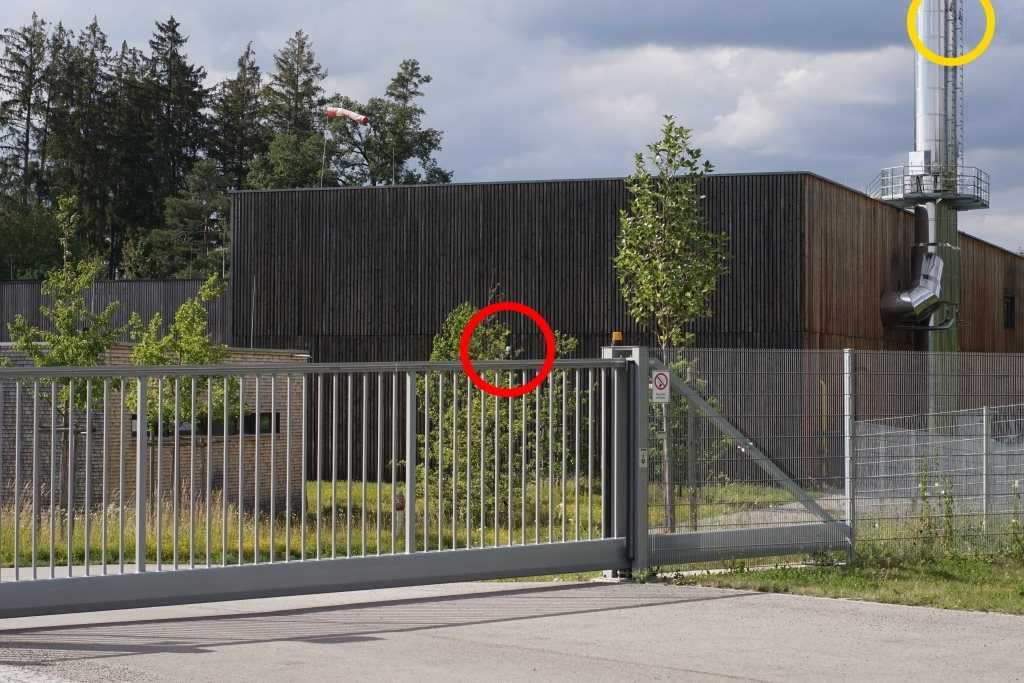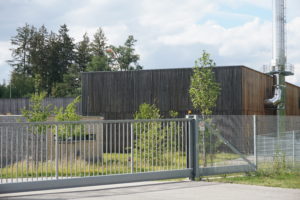Which of the vintage prime and zoom lenses is the sharpest at the focal length of 50mm? And how do they compare to the modern Sony SELP1650 kit lens for the alpha 6000 camera series?
Because the shots were taken with an alpha 6000 camera having an APS-C sensor, the angle of view compares to a 75mm focal length on full frame. Decide yourself which is the best lens by pixel peeping following 100% crops.
The test scenario
All shots at the lens shootout location were shot with a tripod, fixed aperture f8 and ISO 400. Almost the same lighting condition for all lenses. Shutter speed was calculated by the camera for proper exposure by aperture priority automatic mode “A”, which enables manual control of the aperture.
The observation camera marked with a red cycle is used for the 100% crops to check the center quality and the antennas marked with a yellow cycle are used for the 100% crops to check the corner quality:

Now pixel peep yourself, which is the sharpest vintage lens? I included the exposure times.
Modern SELP1650 f3.5-f5.6 kit lens, shot with 1/800s


The SELP1650 APS-C lens is the kit-lens for the alpha 6000 camera series.
Vivitar Series1 24-70mm f3.8-4.8, shot with 1/640s


See details about this lens here: Vivitar Series1 24-70mm f3.8-4.8
Tokina SZ-X 28-200mm f3.5-5.3, shot with 1/500s


Interesting, the tokina lens is much slower than indicated at aperture f8! Two times more light at 1/500s instead 1/1000s of the Minolta and Zeiss lenses means a true f11 aperture instead a fake f8 at 50mm. See details about this lens here: Tokina SZ-X 28-200mm f3.5-5.3
Contax Zeiss T* 50mm f1.7, shot with 1/1000s


See details about this lens here: Contax Zeiss T* 50mm f1.7
Minolta MC Rokkor-PF 50mm f1.7, shot with 1/1000s


See details about this lens here: Minolta MC 50mm f1.7
Which lens wins the 50mm shootout?
In my view, the Minolta MC Rokkor-PF 50mm f1.7 and Contax Zeiss T* 50mm f1.7 are far ahead of the other lenses regarding sharpness and contrast at center and corner. The Minolta lens is even a little bit sharper than the Zeiss, which surprises me. The verdict might be different with full frame sensor shots, as only the sharper middle 2/3 of the lens is used at the shots of this test with an APS-C sensor alpha 6000 camera.
If you have a different verdict, please let me know in a comment below.
By the way, the alpha 6000 camera converted the RAW file of the shot with the Minolta lens into a JPG-file with a filesize of 10366KB, the Zeiss lens into a JPG-file with a filesize of 10144KB while the shot with the kit lens was converted into a JPG-file with a filesize of 8992KB. Better image quality with sharper details results in a larger JPG-file, right?
Here you can download the full 24 mega pixel resolution JPG-files of the SELP1650 and Minolta MC Rokkor-PF lenses to compare the image quality of a kit lens with a good vintage prime lens:


Rundown
This shootout demonstrates, that vintage prime and zoom lenses with 30+ years of age can deliver good or even excellent image quality with modern camera bodies, if the right vintage lens in proper condition is choosen.
Final remarks
Be aware, though, that the classic lenses are fully manual for focus and aperture setting. Also, some classic lenses do not perform well because of fungus, haze or balsam separation, and/or the lens might have been dropped or been treated badly. Look at the Classic Lens Buying Guide and 10-Points Checklist for more details here:
Better not to end up like Jan Eufinger with his Hanimex Hanimar 28mm f2.8, “probably the worst lens of the world“: https://www.youtube.com